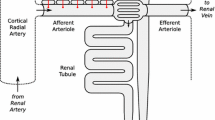Abstract
This paper presents a mathematical model of a system of many coupled nephrons branching from a common cortical radial artery, and accompanying analysis of that system. This modeling effort is a first step in understanding how coupling magnifies the tendency of nephrons to oscillate owing to tubuloglomerular feedback. Central to the present work is the single nephron integral model (as in Pitman et al., The IMA Volumes in Mathematics and Its Applications, vol. 129, pp. 345–364, 2002 and in Zaritski, Ph.D. Dissertation, 1999) which is a simplification of the single nephron PDE model of Layton et al. (Am. J. Physiol. 261, F904–F919, 1991). A second principal idea used in the present model is a coupling of model nephrons, generalizing the work of Pitman et al. (Bull. Math. Biol. 66, 1463–1492, 2004) who proposed a model of two coupled nephrons. In this study, we couple nephrons through a nearest neighbor interaction.
Speaking generally, our results suggest that a series of similar nephrons coupled to their nearest neighbors are more prone to be found in an oscillatory mode, relative to a single nephron with the same properties. More specifically, we show analytically that, for N coupled identical nephrons, the region supporting oscillatory solutions in the time delay–gain parameter plane increases with N. Numerical simulations suggest that, if N nephrons have gains and time delays that do not differ by much, the system is, again, more prone to oscillate, relative to a single nephron, and the oscillations tend to be approximately synchronous and in-phase. We examine the effect of parameters on bifurcation. We also examine alternative models of coupling; this analysis allows us to conclude that the increased propensity of coupled nephrons to oscillate is a robust finding, true for several models of nephron interaction.
Similar content being viewed by others
References
Barfred, M., Mosekilde, E., Holstein-Rathlou, N.-H., 1996. Bifurcation analysis of nephron pressure and flow regulation. Chaos 6, 280–287.
Bayram, S., Analysis of TGF-mediated dynamics in a system of many coupled nephrons. Ph.D. Dissertation, State University of New York at Buffalo.
Briggs, J., 1982. A simple steady-state model for feedback control of glomerular filtration rate. Kidney Int. 22(Suppl. 12), S143–S150.
Casellas, C., Moore, L.C., 1990. Autoregulation and tubuloglomerular feedback in juxtamedullary glomerular arterioles. Am. J. Physiol. 258, F660–F669 (Renal Fluid Electrolyte Physiol. 27).
Casellas, D., Dupont, M., Bouriquet, N., Moore, L.C., Artuso, A., Mimran, A., 1994. Anatomic pairing of afferent arterioles and renin cell distribution in rat kidneys. Am. J. Physiol. 267, F931–F936 (Renal Fluid Electrolyte Physiol. 36).
Chen, Y.-M., Yip, K.-P., Marsh, D.J., Holstein-Rathlou, N.-H., 1995. Magnitude of TGF-initiated nephron–nephron interaction is increased in SHR. Am. J. Physiol. 269, F198–F204 (Renal Fluid Electrolyte Physiol. 38).
Cupples, W.A., Novak, P., Novak, V., Salevsky, F.C., 1996. Spontaneous blood pressure fluctuations and renal blood flow dynamics. Am. J. Physiol. 270, F82–F89 (Renal Fluid Electrolyte Physiol. 39).
Holstein-Rathlou, N.-H., 1987. Synchronization of proximal intratubular pressure oscillations: evidence for interaction between nephrons. Pflügers Arch. 408, 438–443.
Holstein-Rathlou, N.-H., Leyssac, P.P., 1986. TGF-mediated oscillations in proximal intratubular pressure: Differences between spontaneously hypertensive rats and Wistar–Kyoto rats. Acta Physiol. Scand. 126, 333–339.
Holstein-Rathlou, N.-H., Marsh, D.J., 1989. Oscillations of tubular pressure, flow, and distal chloride concentration in rats. Am. J. Physiol. 256, F1007–F1014 (Renal Fluid Electrolyte Physiol. 25).
Holstein-Rathlou, N.-H., Marsh, D.J., 1990. A dynamic model of the tubuloglomerular feedback mechanism. Am. J. Physiol. 258, F1448–F1459 (Renal Fluid Electrolyte Physiol. 27).
Just, A., Wittmann, U., Ehmke, H., Kirchheim, H.R., 1998. Autoregulation of renal blood flow in the conscious dog and the contribution of the tubuloglomerular feedback. J. Physiol. 506(1), 275–290.
Källskog, Ö., Marsh, D.J., 1990. TGF-initiated vascular interactions between adjacent nephrons in the rat kidney. Am. J. Physiol. 259, F60–F64 (Renal Fluid Electrolyte Physiol. 28).
Layton, H.E., Pitman, E.B., Moore, L.C., 1991. Bifurcation analysis of TGF-mediated oscillations in SNGFR. Am. J. Physiol. 261, F904–F919 (Renal Fluid Electrolyte Physiol. 30).
Leyssac, P.P., 1986. Further studies on oscillating tubulo-glomerular feedback responses in the rat kidney. Acta Physiol. Scand. 126, 271–277.
Leyssac, P.P., Baumbach, L., 1983. An oscillating intratubular pressure response to alterations in Henle flow in the rat kidney. Acta Physiol. Scand. 117, 415–419.
Pitman, E.B., Layton, H.E., Moore, L.C., 1993. Dynamic flow in the nephron: filtered delay in the TGF pathway. Contemp. Math. 141, 317–336.
Pitman, E.B., Zaritski, R.M., Moore, L.C., Layton, H.E., 2002. A reduced model for nephron flow dynamics mediated by tubuloglomerular feedback. In: Layton, H.E., Weinstein, A.M. (Eds.), Membrane Transport and Renal Physiology, The IMA Volumes in Mathematics and its Applications, vol. 129, pp. 345–364. Springer, New York.
Pitman, E.B., Zaritski, R.M., Kesseler, K.J., Moore, L.C., Layton, H.E., 2004. Feedback-mediated dynamics in two coupled nephrons. Bull. Math. Biol. 66, 1463–1492.
Stepien, T.L., 2008. Tubuloglomerular feedback-mediated dynamics in three coupled nephrons. Honors Thesis, State University of New York at Buffalo.
Sosnovtseva, O.V., Postnov, D.E., Mosekilde, E., Holstein-Rathlou, N.-H., 2003. Synchronization of tubular pressure oscillations in interacting nephrons. Chaos Solitons Fractals 15, 343–369.
Wagner, A.J., Holstein-Rathlou, N.-H., Marsh, D.J., 1997. Internephron coupling by conducted vasomotor responses in normotensive and spontaneously hypertensive rats. Am. J. Physiol. 272, F372–379 (Renal Physiol. 41).
Yip, K.-P., Holstein-Rathlou, N.-H., Marsh, D.J., 1991. Chaos in blood flow control in genetic and renovascular hypertensive rats. Am. J. Physiol. 261, F400–F408 (Renal Fluid Electrolyte Physiol. 30).
Yip, K.-P., Holstein-Rathlou, N.-H., Marsh, D.J., 1992. Dynamics of TGF-initiated nephron–nephron interactions in normotensive rats and SHR. Am. J. Physiol. 262, F980–F988 (Renal Fluid Electrolyte Physiol. 31).
Zaritski, R.M., 1999. Models of complex dynamics in glomerular filtration rate. Ph.D. Dissertation, State University of New York at Buffalo.
Author information
Authors and Affiliations
Corresponding author
Rights and permissions
About this article
Cite this article
Bayram, S., Stepien, T.L. & Pitman, E.B. TGF-Mediated Dynamics in a System of Many Coupled Nephrons. Bull. Math. Biol. 71, 1482–1506 (2009). https://doi.org/10.1007/s11538-009-9410-1
Received:
Accepted:
Published:
Issue Date:
DOI: https://doi.org/10.1007/s11538-009-9410-1




